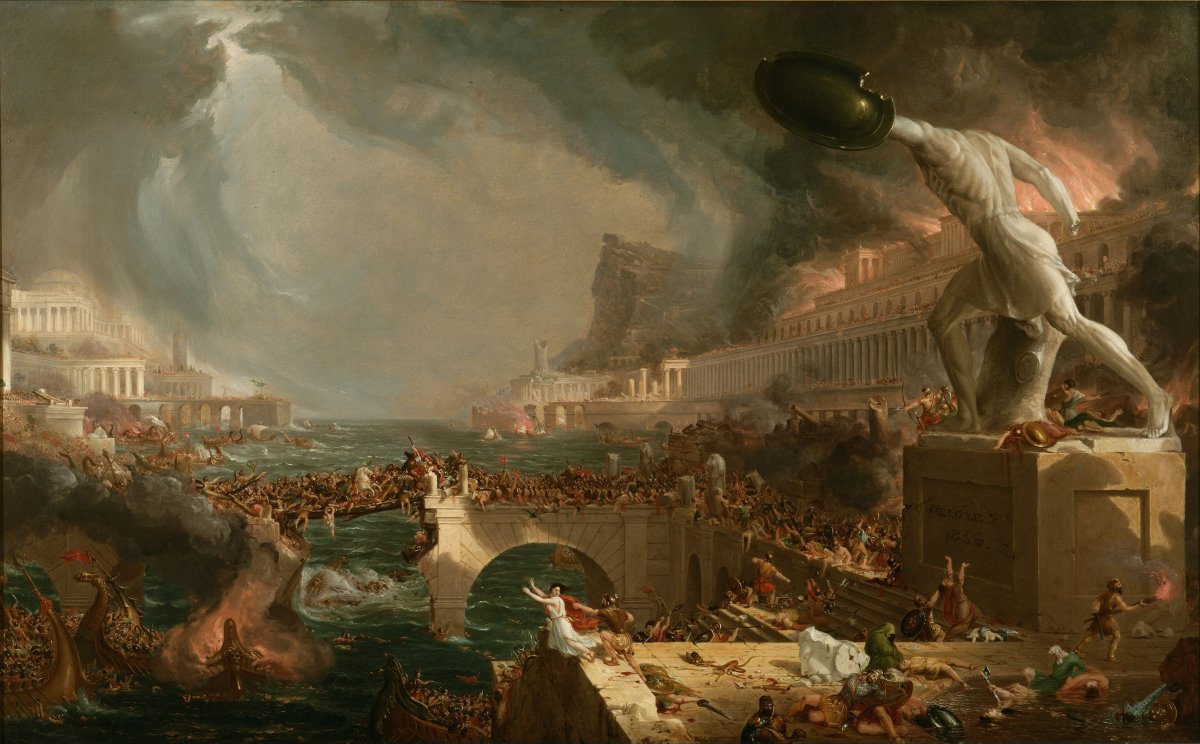If you were to ask someone on the street what they know about the end of the Roman Empire, they might give you key words, like “barbarians,” “invasion,” or “decline;” or perhaps a date, like “410” or “476.”
In popular culture and imagination, the fall of the Roman Empire takes on the shape of a cataclysmic event, the contours of which have been altered little since Edward Gibbon’s famous eighteenth century work, The Decline and Fall of the Roman Empire.
Scholarship on this period, however, has changed a lot since 1800 and has simply exploded in the last fifty years. Much research has emphasized continuity alongside change, especially in religious and cultural spheres, and attempted to dispel the fearsome notion of the “dark ages.” In the 2000s, several popular books reacted against this academic trend, reminding their audience (who likely had not heard otherwise) that Rome really did fall to violent barbarians, and it really was catastrophic.
This is perhaps a useful context for understanding Pennsylvania State University historian Michael Kulikowski’s most recent work, The Tragedy of Empire: From Constantine to the Destruction of Roman Italy. This book is the sequel to The Triumph of Empire: The Roman World from Hadrian to Constantine (2016) and continues Kulikowski’s series of political histories for a popular audience.

In many ways, this book is very traditional: it presents the political and institutional history of the later Roman Empire, and with it the notion that Rome fell. The Tragedy of Empire tells an unabashed story of decline and chaos in the Western Empire (parts of Western Europe and Northern Africa) though not in the East (the Eastern Balkans, Anatolia, the Levant, and Egypt). Even as it is part of the recent trend of declension literature, it pushes, at times sharply, against sudden, cataclysmic, barbarian migration-driven explanations of the Fall of Rome.
The central goal for The Tragedy of Empire is to narrate the formation and dissolution of the distinctive Late Roman “political economy,” created by the reforms of Diocletian and Constantine.
There are a few major trends that Kulikowski tracks throughout the book: first, the need for and pitfalls of having multiple emperors, East and West; second, the power of local, regional, and palatine military and civilian administrators and leaders; and third, the Christianization of the empire and, most importantly for Kulikowski, its emperors.
The book is split into fifteen chapters. The first four (Ch. 1-4) explore the state of affairs in the fourth century, the point of departure for the rest of the story. Constantine is shown as a political revolutionary and an ardent influencer in church politics, while Julian flounders after becoming augustus and Jovian emerged as the first “compromise candidate” chosen to be emperor by those more powerful than he.
The Emperor Constantine I, r. 306-337
The joint rule of Valentinian (r. 364-375) and Valens (r. 364-378) solidified the administrative and conceptual boundaries between the Eastern and Western halves of the empire. The next five chapters (Ch. 5-9) cover the Theodosian emperors, and perhaps more importantly, the powerful, fractious networks of elites, bishops, generals and administrators that both supported and undermined them. In the East, this resulted in an established network, but in the West, in constant leadership turnover and attendant instability.
Chapters 10-12 narrate the demise of the Western Empire as a political entity, which for Kulikowski unfolds over the decades leading up to 476. Even as the West disintegrates, post-Theodosian emperors in the East like Zeno (r. 474-491) were consumed by the intricacies of governing, which further highlights the economic and administrative disparities, and religious disputes, between East and West.
Chapters 13-15 describe the establishment of the post-Roman western kingdoms and the context of the wars of reconquest led by the emperor Justinian (r. 527-565). Indeed, Justinian’s reign and wars completed the transition to the Middle Ages in the West and jump-started it in the East.

The Emperor Justinian I, r. 527-565
In the end, the late Empire’s massive size, multiple rulers, and powerful military apparatus were factors in its instability, as were the “barbarians” whose ethnic identities were formed in relation to the Empire.
Reflecting recent scholarship, The Tragedy of Empire’s narrative highlights the contingency of these developments: bad luck and unintended consequences explain more than unspecified malaise or apocalyptic invasion.
Most of the protagonists of this traditional political history are emperors and generals, but Kulikowski does point to the strategic contributions of imperial women, the influential jockeying of bishops, and the far-reaching impact of the religious conflicts in this period.
This is an institutional history in a broader sense: it tracks the imperial family, the administration, the military and the church, even as these entities constantly shape-shift, overlap, and intersect.
It is hard to know how to evaluate a book like The Tragedy of Empire, which summarizes and narrates far more than it argues or analyzes. Where small arguments are made, they are subtle and hard for a reader to trace because of the lack of footnotes or endnotes.
Fierce scholarly debate, especially on the interpretation of literary sources, is (by necessity) skimmed over, but without real citation, the reader may not know where to follow up. While there is a “Further Reading” section subdivided by century, it perhaps does not do enough to pinpoint the book’s sources and positions.
The book also includes twenty-five high-quality color images and lengthy descriptions, but they are not analyzed or even referenced in the text. Including and yet not referencing these excellent images seems to be a missed opportunity for cultural contextualization
The Tragedy of Empire is an admirable and skillful political narrative history, but in its focus on institutions and emperors, it perhaps unwittingly reproduces the old idea that the post-Roman west fell into some sort of darkness; the cultural splendor of “later late antiquity” was the purview of the East alone. Such intense scrutiny on the ultimately unanswerable question of why and how Rome fell obscures other equally worthy questions.
